| |
|
|
|
|
English Family Quick Links
|
|
|
|

|
|
|
|
|
Family 26: Old Merlin Mare
 |
VIEW DESCENT CHART
The first mention of this mare in the General Stud Book is in the entry of her great-grand daughter, Salome, sometimes called Selima, by Bethell's Arabian, born sometime around 1730-34, as indicated by the dates of her offspring. Salome ran at least once, placing second in a King's Plate at four miles for mares at Hambleton in 1738.
The (Old) Merlin mare and her descendants, up to and probably including Salome, were Yorkshire-bred horses. (Old) Merlin was bred sometime around 1694 by Sir Matthew Pierson (sometimes Pearson), who had a stud at Lowthorpe, in the East Riding, Yorkshire. Bruce Lowe placed a full sister to the dam of (Old) Merlin at the head of Family 37. Old Merlin was by Bustler, a son of the Helmsley Turk. The Merlin mare's dam, Merlin's dam, and Bustler's dam have not been identified, and it seems likely one or more of these mares sprang from running stock that had been bred in the north of England for generations.
Old Merlin ran in several races in the north, and at least one at Newmarket, commemorated by song, which refers to Merlin as "Little Merlin," a possible clue to his stature and perhaps his origins as a galloway. The horse was sold to or shared with Sir William Strickland, Pierson's long-time associate in horse racing, and another important breeder of early thoroughbreds. Old Merlin was retired to stud at Sir William's stud at Boynton, East Yorkshire, not far north of Lowthorpe; his plates were still on the door of his box there in the early 20th century.
The breeder of the Merlin mare is not known at present, although it seems likely it was Pierson or Strickland. The breeder of her daughter, who was by the Darley Arabian, is also not stated. However, the Darley Arabian, who arrived in Great Britain in 1704 at age 4, stood his entire life at the stud of Richard Darley, at Aldby Park in East Yorkshire. Darley died two years after this famous horse's arrival, and the property passed to his son, Henry, and afterwards, in 1720, passed to Henry's sister, Jane, who was married to John Brewster, whose son, Henry, took the name of Darley. John Brewster was the breeder of (Graham's) Champion, from a Hautboy mare that had belonged to Sir Mathew Pierson. Champion, born in 1707, was bred to the Merlin mare's daughter by the Darley Arabian.
This Champion mare was the dam of Salome, whose sire was Bethell's Arabian. Hugh Bethell inherited the manor and estate of Rise in East Yorkshire, from his uncle, Sir Hugh Bethell, and it seems likely his arabian was located there.
Several of Salome's offspring, including Cypron, the good producer whose name is largely known to us through her son, (King) Herod, were bred by Sir William St. Quintin, 4th Bt., whose family had occupied a seat at Lowthorpe in East Riding since the 14th century. |
Old Merlin Mare's
Known Produce:
Mare by Darley Arabian. Dam of
f. Mare by (Graham's) Champion. Dam of
f. Salome (Selima) by Bethell's Arabian. Dam of
f. by Starling
c. Scampston Cade (1747) by Cade
f. Cypron (1750) by Blaze
f.(1751) by Hutton's Spot
f.(1752) by (Bolton) Starling
c. (1754) by Cade
|
|
|
FAMILY #26 NOTABLE DESCENDANTS
|
|
Family #26 Oaks Winners
|
|
|
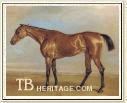 |
|
|
|
Augusta
|
|
|
|
1780 TETOTUM b.f. 1777
(Matchem - Lady Bolinbroke) |
|
1821 AUGUSTA b.f. 1818
(Woful - mare by Rubens) |
| |
Family #26 Derby Winners
|
|
|
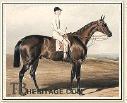 |
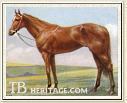 |
|
Coronation
|
Orby
|
|
1841 CORONATION b.c. 1838
(Sir Hercules - Ruby) |
1907 ORBY ch.c. 1904
(Orme - Rhoda B.)
|
|
|
Family #26 St. Leger Winners
|
|
|
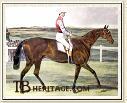 |
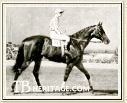 |
|
Knight of St. George
|
Solario
|
|
1854 KNIGHT OF ST. GEORGE b.c. 1851
(Birdcatcher - Maltese) |
1925 SOLARIO b.c. 1922
(Gainsborough- Worship)
|
|
|
Family #26 Other Family Members
|
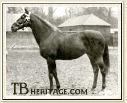 |
|
Bill of Portland
|
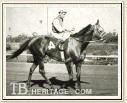 |
|
Crimson Satan
|
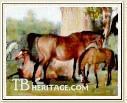 |
|
Cypron
|
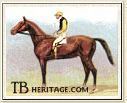 |
|
Darriwell
|
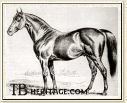 |
|
Glenelg
|
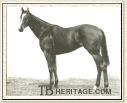 |
|
Gloaming
|
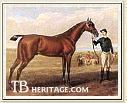 |
|
Herod
|
 |
|
Museum
|
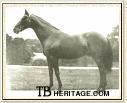 |
|
Perplexe
|
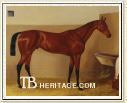 |
|
Promised Land
|
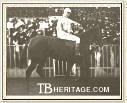 |
|
Ronde de Nuit
|
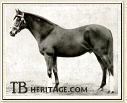 |
|
Roseland
|
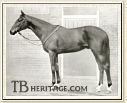 |
|
Tolgus
|
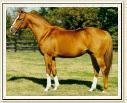 |
Trempolino
Courtesy Tony Leonard
|
|
Bill of Portland b. c. 1890
(St. Simon - Electric Light)
Known as a roarer, he stood for several years in Great Britain before export to Australia, where he had great success at stud, in the top ten of leading sires there several times, including second in 1899-1900. Considered a source of stamina. He left sons Bobadil (1895, champion racehorse at 3, sire of Melbourne Cup winner The Parisian, and in the top ten in leading sires list for 11 years) and Maltster (1897, 5 times leading sire), both of whom became top sires in Australia, and Meriwee (1896, VRC Derby and Melbourne Cup), Finland (1897, VRC St. Leger, SAJC Goodwood Handicap) and Treadmill (1900), top sires in New Zealand. Some of his daughters, sent to South America, were also highly successful, including Valemont (1909, sent to Chile), dam of Mary Garden, a classic winner who ran for seven years and was a top broodmare. Bill of Portland was eventually sent back to England where he got some winners, later sold to Belgium. |
Coronation b.c. 1838
(Sir Hercules - Ruby)
A rich bay colt who won two sweepstakes at age 2, and three races at age 3, including the Derby Stakes and the Cup at Oxford, running second in the St. Leger by a head. Through a daughter, The British Queen, ancestor of some good race horses in France, including French Oaks winner Rose de Mai, second dam of Rose Prince. |
Crimson Satan ch. c. 1959
(Spy Song - Papila)
Long-running handicap horse won 18 of his 58 races, including The Washington Park Handicap, the Michigan Mile, where he established a new track record carrying the top weight, the Clark Handicap, and others. Got some good race fillies, including Crimson Saint (Meteor Handicap twice, dam of Pancho Villa, Terlingua and Royal Academy) and Queen Louie (top juvenile filly in Canada). |
Darriwell ch.c. 1874
(Tim Whiffler - Norna)
Won the Melbourne Cup of 1879; at stud Australia he got some good winners, including Cheddar (1887) (SAJC Australian Derby), Harridan (1888) (WATC Australian Derby) and Clock Na Bien (1890) (SAJC Morphettville Plate), but could not carry on the sire line. |
Glenelg b.c. 1866
(Citadel - Bapta)
Imported into the U.S. in utero from Great Britain, and purchased as a yearling by August Belmont. Temperamental and large, he was started at age 3, and proved to be the best of his generation, winning the Travers and Jerome Stakes, among others. Also a very good older horse, winning the Breakfast Stakes, Bowie Stakes and Maturity Stakes. At stud in Kentucky, and later Tennessee, he became leading American sire 4 times in the 1880s. Known for transmitting soundness, among his get was She, top 3 year old filly of 1876; Monitor (Dixie Handicap, Jerome Handicap); Idalia (Juvenile Stakes, Ladies Handicap) and her stakes-winning siblings, Dan Sparling (Withers Stakes) and Charley B. (Travers Stakes); sisters Aella (Ladies Handicap, Aqueduct, dam of The Great Ruby, Prince George, and Senella) and Ferida (Alabama Stakes); Firenzi (Nursery Handicap, Jerome Handicap, Gazelle Stakes), and many more. |
Gloaming b.g. 1915
(The Welkin - Light)
Plain-headed, good-moving post-World War I hero of Australasia won 57 of his 67 races, placing second nine times. By a modest runner that become leading sire in Australia three times, and out of a non-winning mare by July Cup winner Eager that in Australia bred three other winners. Born in Australia and purchased as a yearling by New Zealander George Greenwood, he was trained in New Zealand, and raced in both countries, crossing the Tasman sea fifteen times during his career. Among his many wins were the AJC Derby, the New Zealand Derby, and the Great Northern Derby, he was the first to win all three. He won at all distances, from four fulrongs to 1-1/2 miles, with blazing speed and great weight-carrying ability. |
Herod b. c. 1758
(Tartar - Cypron)
Principal conduit of the Byerley Turk line, leading sire in Great Britain eight times, he founded a sire line dynasty; son Highflyer also led the list thirteen times, and grandson Sir Peter Teazle nine times. |
Knight of St. George b. c. 1861
(Birdcatcher - Maltese)
Irish-bred horse won the Doncaster St. Leger. Later sent to Kentucky, Through daughter Brenna, ancestor of Preakness Stakes winner The Bard; Knight of St. Patrick was his best son, sire of Moslem, shared winner of the 2,000 Guineas. |
Museum b. c. 1932
(Phalaris or Legatee - Imagery)
Born in England and trained in Ireland, where he was the first winner of the Irish Triple Crown; he also won the Great Ebor Handicap at York. Not a successful sire, he was sent to Scandinavia in 1946. |
Orby ch. c. 1904
(Orme - Rhoda B)
Born in England, raised and trained in Ireland, he only ran seven times, winning four races, including the Epsom Derby and the Irish Derby at the Curragh. Retired to Glencairn Stud in Ireland, his offspring included 1919 Derby winner Grand Parade; Diadem (1,000 Guineas winner in 1917), the top sprinter Glanmerin, good race mare and producer Cos, the excellent handicapper Diadumenos, the speedy Flying Orby, and The Boss, sire of Golden Boss. |
Perplexe b. c. 1872
(Vermout - Peripetie)
Good French runner and sire, took the Grand Criterium and at age three the Prix-Royal Oak. Leading sire in France in 1893, he got five classic winners, including Ragotsky, Perplexite, Sycomore, Sakountala, and Fra Angelico, later a classic sire himself. His dam, Peripetie won the Prix Daru and Prix de Diane; through a daughter she was third dam of the great filly Ronde de Nuit. Peripetie's dam, Peronnelle (1854, by Elthiron) established a female branch, still active, that included Swing Till Dawn, Crimson Satan, the good racemare Foliation. |
The Promised Land br. c. 1856
(Jericho - Glee)
Good runner of 1859, he won the 2,000 Guineas and the Goodwood Derby that year. Through daughter Cast Off, broodmare sire of Robert the Devil (1877, by Bertram, top race horse who won the Grand Prix de Paris, Doncaster St. Leger, the Ascot Gold Cup and other races, besting Bend Or twice, but losing to him in the Derby by a head). |
Rhodora br. f. (1905)
(St. Frusquin - Rhoda B.)
Winner of the Dewhurst Stakes and 1,000 Guineas, mishap caused her to lose the Oaks. Produced just one foal that died young. |
Ronde de Nuit b. f. (1906)
(William the Third - Halte-La)
Talented French-bred filly won eight races, including the Poule d'Essai des Pouliches (French One Thousand Guineas), the Prix Vermeille, the Prix de la Foret, the Prix La Rochette, and Prix Edgard Gillois. Her female line carried on, with Grand Prix de Paris winner Valiant Heart (1977) one of the most recent representatives. |
Roseland br. c. 1912
(William the Third - Electric Rose)
Won the Fitzwilliam Stakes and the July Stakes at Newmarket at age 2, and second in the New Stakes at Ascot; at three, he won the Bickerstaffe Stakes at Liverpool, his only race. His brother, Roseworthy (sent to Australia), was a better racehorse, winning the St. James' Palace Stakes, and the Criterion Stakes among others. Most notable for siring Garron Lass, the dam of Friar's Daughter, who produced Bahram, Dastur, Fille d'Amour, Sadruddin and other good horses. Roseland also got Bower of Roses, a good race filly who won the Irish Cesarewitch among 8 others in her six year career, and was dam of unbeaten juvenile and later Irish Derby winner, Rosewell. |
Solario br.c. 1922
(Gainsborough - Sun Worship)
His six wins during his career, ages 2 to 4, included the St. Leger, the Ascot Derby, Ascot Gold Cup and Coronation Cup. Leading sire in England in 1937, and twelve times in the top ten list, he got, among others, Dastur (Irish Derby, Coronation Cup, and other tops stakes, good broodmare sire), Estoril (dam of war time French winner Escamillo), Solar Flower (Coronation Stakes, dam of Arctic Sun, Solar Slipper), Tai Yang (Jockey Club Stakes), Mid-Day Sun (Derby, Hardwicke Stakes, sire), and many others. |
Tolgus b.c. 1923
(Stefan the Great - Rosa Croft)
Unbeaten winner of six races at ages 2 and 3--he was not entered in the classics. His wins included Kempton's Imperial Produce Stakes, Liverpool's Bickerstaffe Stakes, Lingfield's Spring Stakes. His best offspring was Lovely Rosa (Epsom Oaks). His dam, Rosa Croft, was sister to Roseland (above). |
Trempolino ch. c. 1984
(Sharpen Up - Trephine)
Good three year old in France, won the Prix de Courcelles, the Prix de l'Arc de Triomphe, and second in the Prix du Jockey Club, in all won 4 races and placed 7 times. Offspring include Juvenia (Prix Marcel Boussac), Dernier Empereur (Champion Stakes, Prix Guillaume d'Ornano, Del Mar Invitational Handicap, and others), Germany (Grosser Preis von Baden-Baden and others), Arcadian Hero (Ripon Champion Trophy Stakes and others). |
|
| |
|
|
|
|
|

